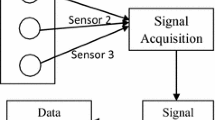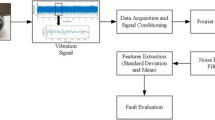Abstract
Aiming at the problem that earth-rock dam structure is susceptible to non-stationary signal interference in the process of collecting vibration information, this paper proposes a feature information extraction method based on the fusion of Dispersion Entropy Variational Mode Decomposition (DVMD) and Variance Dedication Rate (VDR) improved by Dispersion Entropy. First, multi-channel vibration signals are dynamically fused using the variance dedication rate to extract the complete vibration information of the dam body; then the entropy value of each modal component (Intrinsic Mode Function) under different decomposition layers is calculated by using Dispersion Entropy, and the entropy turning point is selected to determine the number of decomposition modes of DVMD, to compensate for the insufficiency of blind selection of decomposition modes in Variational Mode Decomposition. The entropy value turning point is selected to determine the number of decomposition modes of DVMD, which can make up for the deficiency of blindly selecting decomposition modes in Variational Mode Decomposition. To verify the accuracy and effectiveness of the method in this paper, three groups of simulated signals are constructed for numerical simulation, and it is found that its noise reduction effect is better than that of digital filtering, wavelet thresholding and Improved Variational Mode Decomposition, and the signal feature information can be effectively extracted. Combining the measured data of the embankment dam of HeLong dam site under the excitation of natural environment, the operational characteristic information of the dam body is analyzed and compared with the finite element simulation results, and the study shows that the DVMD–VDR method can efficiently extract the complete vibration characteristic information of the structure, which has a good engineering practicability, and it can provide the basis for the on-line monitoring of the structural operational status of the embankment dam.






















Similar content being viewed by others
Data availability
The data that has been used is confidential.
References
ICOLD (2010) Geomembrane sealing systems for dams: design principles and return of experience (Bulletin 135)[R]. Paris: The International Commission on Large Dams
Zhang CH, Jin F, Wang JY et al (2016) Key issues and developments on seismic safety evaluation of high concrete dams[J]. J Hydraul Eng 47(3):253–264
Wang Y, Han M, Li B et al (2022) Stability evaluation of embankment dam reinforcement with new permeable polymer based on reliability method[J]. Constr Build Mater 320:126294
Chen W, Wang X, Tong D et al (2021) Dynamic early-warning model of dam deformation based on deep learning and fusion of spatiotemporal features[J]. Knowl-Based Syst 233:107537
Li J, Bao T, Ventura CE (2022) An automated operational modal analysis algorithm and its application to concrete dams[J]. Mech Syst Signal Process 168:108707
Wei B, Xie B, Li H et al (2021) An improved Hilbert-Huang transform method for modal parameter identification of a high arch dam[J]. Appl Math Model 91:297–310
Cantieni R (2001) Assessing a dam’s structural properties using forced vibration testing, In Proc IABSE international conference on safety, risk and reliability-trends in engineering, Malta
Tarinejad R, Ahmadi M, Harichandran R (2014) Full-scale experimental modal analysis of an arch dam: the first experience in Iran. Soil Dyn Earthq Eng 61:188–196
Gauron O, Boivin Y, Ambroise S et al (2018) Forced-vibration tests and numerical modeling of the Daniel-Johnson multiple-arch dam. J Perform Constr Facil 32(2):04017137
Sevim B, Bayraktar A, Altunisik AC (2011) Finite element model calibration of berke arch dam using operational modal testing. J Vib Control 17:1065–1079
Lian JJ, Li HK, Zhang JW (2009) ERA modal identification method for hydraulic structures based on order determination and noise reduction of singular entropy. Sci China Ser E Technol Sci 52(2):400–412
Wei BW, Xie B, Li HK et al (2021) An improved Hilbert-Huang transform method for modal parameter identification of a high arch dam. App Math Model 91:297–310
Tarinejad R, Pourgholi M (2018) Modal identification of arch dams using balanced stochastic subspace identification. J Vib Control 24:2030–2044
Sevim B, Altunisik AC, Bayraktar A (2012) Earthquake behavior of Berke arch dam using ambient vibration test results. J Perform Constr Facil 26:780–792
Pereira S, Magalhães F, Gomes JP et al (2021) Vibration-based damage detection of a concrete arch dam[J]. Eng Struct 235:112032
Dufour F, Guo X, Humbert N (2022) Modal analysis of an arch dam combining ambient vibration measurements, advanced fluid-element method and modified engineering approach[J]. Earthq Eng Struct Dyn 51(6):1321–1342
Xiang ZQ, Pan JW, Wang JT et al (2022) Improved approach for vibration-based structural health monitoring of arch dams during seismic events and normal operation[J]. Struct Control Health Monit 7:29
Li HK, Wu PZ, Huang W et al (2022) Joint noise reduction method of hydraulic structure vibration signals based on CEEMDAN and improved wavelet threshold[J]. J Nanchang Univ Eng Technol 44(01):1–8
Zhang Y, Lian J, Liu F (2016) An improved filtering method based on EEMD and wavelet-threshold for modal parameter identification of hydraulic structure[J]. Mech Syst Signal Process 68:316
Zhang JW, Hou G, Hua WW et al (2018) Damage diagnosis of hydraulic structure based on VMD and HHT marginal spectrum[J]. J Vib Meas Diagn 38(04):852–858
Yang J, Stewart E, Ye J, Entezami M, Roberts C (2023) An Improved VMD method for use with acoustic impact response signals to detect corrosion at the underside of railway tracks[J]. Appl Sci 13(2):942
Yu H, Huang W, Du B (2023) SSA-VMD for UWB Radar Sensor Vital Sign Extraction[J]. Sensors 23(2):756
Ni Q, Ji JC, Feng K et al (2022) A fault information-guided variational mode decomposition (FIVMD) method for rolling element bearings diagnosis[J]. Mech Syst Signal Process 164(5):108216
Markert R, Xiang J, Zheng W (2015) Research on variational mode decomposition and its application in detecting rub-impact fault of the rotor system[J]. Mech Syst Signal Process 60:243
Dragomiretskiy K, Zosso D (2014) Variational mode decomposition. IEEE Trans Signal Processing 62(3):531
Tang GJ, Xu ZL, Pang B et al (2022) Gear fault diagnosis based on SSWPT marginal spectrum feature information extraction[J]. J Vib Shock 41(14):50–57
Zhang J, Hou G, Wang H, Zhao Y, Huang J (2020) Operation feature extraction of flood discharge structure based on improved variational mode decomposition and variance dedication rate. J Vib Control 26(34):229
Long C, Yu CB, Wang H (2022) Fault detection method of air conditioner external unit based on improved variational modal decomposition and residual network[J]. J Ordnance Equip Eng 43(12):278–282
Wang Y, Markert R, Xiang J, Zheng W (2015) Research on variational mode decomposition and its application in detecting rub-impact fault of the rotor system. Mech Syst Signal Process 60:243
Li J, Chen Y, Lu C (2020) Application of an improved variational mode decomposition algorithm in leakage location detection of water supply pipeline[J]. Measurement 173(8):108587
Azami H, Rostaghi M, Fernández A, Escudero J (2016) Dispersion entropy for the analysis of resting-state MEG regularity in Alzheimer's disease. In: Conference proceedings : annual international conference of the IEEE engineering in medicine and biology society.
Li Y, Jiao S, Gao X (2021) A novel signal feature extraction technology based on empirical wavelet transform and reverse dispersion entropy[J]. Defence Technol 17(5):1625–1635
Zhang J, Hou G, Cao K, Ma B (2018) Operation conditions monitoring of flood discharge structure based on variance dedication rate and permutation entropy[J]. Nonlinear Dyn 93(4):2517
Li H, Liu B, Huang W, Liu H, Wang G (2022) Vibration load identification in the time-domain of high arch dam under discharge excitation based on hybrid LSQR algorithm[J]. Mech Syst Signal Process 177:109193
Kim J, Kim K, Sohn H (2014) Autonomous dynamic displacement estimation from data fusion of acceleration and intermittent displacement measurements[J]. Mech Syst Signal Process 42(1–2):194
Wang G, Li H, Fu Z, Huang W, Liu B, Yao S (2023) A novel methodology for modal parameter identification of arch dam based on multi-level information fusion[J]. Mech Syst Signal Process 183:109587
Yang CM, Yu JC, Chu PY, Hsieh CH, Wu MH (2022) The utilization of tunable transducer elements formed by the manipulation of magnetic beads with different sizes via optically induced dielectrophoresis (ODEP) for high signal-to-noise ratios (SNRs) and multiplex fluorescence-based biosensing applications[J]. Biosensors 12(9):755
Yu H, Li H, Li Y (2020) Vibration signal fusion using improved empirical wavelet transform and variance dedication rate for weak fault detection of hydraulic pumps[J]. ISA Trans 107:385–401
Song Z, Cao Q, Dai Q (2019) Free vibration of truncated conical shells with elastic boundary constraints and added mass[J]. Int J Mech Sci 155:286–294
Jiang H, Jiang A, Xu M (2022) Research on algorithm and coupling damage model of rock under high temperature and loading based on mohr-coulomb criterion[J]. Int J Comput Methods 19(04):2250001
Wang F, Song Z, Liu Y et al (2020) Seismic wave input method for high earth dams considering the transmission amplification effect of the bedrock-overburden interface[J]. Comput Geotech 130(12):103927
Gong J, Zou D, Kong X et al (2021) The simulation of high compressive stress and extrusion phenomenon for concrete face slabs in CFRDs under strong seismic loads[J]. Soil Dyn Earthq Eng 147(2):106792
Dingyu C, Kegui X, Quanquan Qi (2013) Research on modal parameter identification characteristics of extended feature system implementation algorithm [J]. Eng Mech 30(08):49–53
Qianhui Pu, Hong Yu, Gaoxin W et al (2018) Fast feature system implementation algorithm for structural modal parameter identification under environmental excitation [J]. Vib Impact 37(06):55–60
Acknowledgements
This work was supported by the National Natural Science Foundation of China (Grant No. 52279133).
Author information
Authors and Affiliations
Corresponding author
Ethics declarations
Conflict of interest
The authors declare that they have no known competing financial interests or personal relationships that could have appeared to influence the work reported in this paper.
Additional information
Publisher's Note
Springer Nature remains neutral with regard to jurisdictional claims in published maps and institutional affiliations.
Rights and permissions
Springer Nature or its licensor (e.g. a society or other partner) holds exclusive rights to this article under a publishing agreement with the author(s) or other rightsholder(s); author self-archiving of the accepted manuscript version of this article is solely governed by the terms of such publishing agreement and applicable law.
About this article
Cite this article
Zhang, J., Li, Z., Jiang, Q. et al. Analysis of structural vibration characteristics of embankment dam based on DVMD–VDR. J Civil Struct Health Monit (2024). https://doi.org/10.1007/s13349-024-00782-0
Received:
Accepted:
Published:
DOI: https://doi.org/10.1007/s13349-024-00782-0




